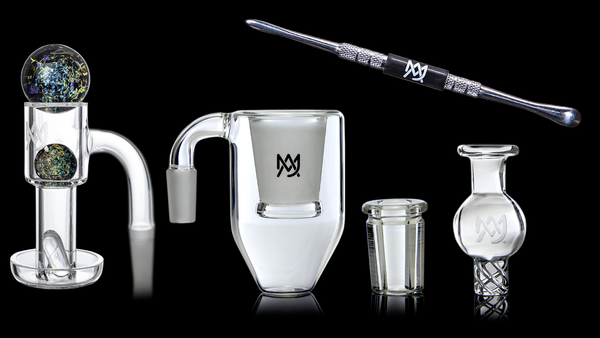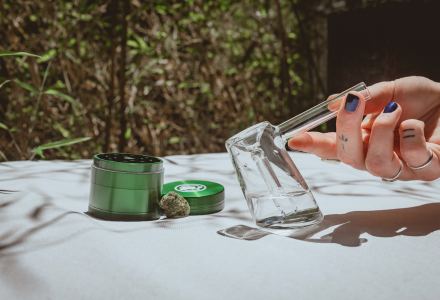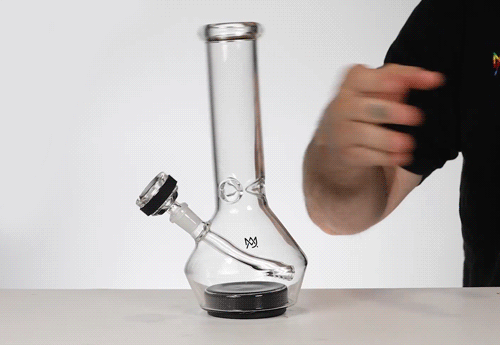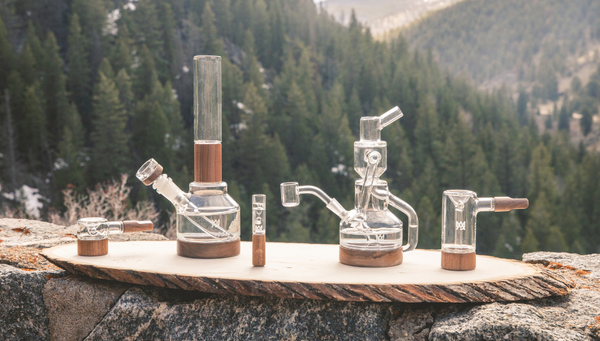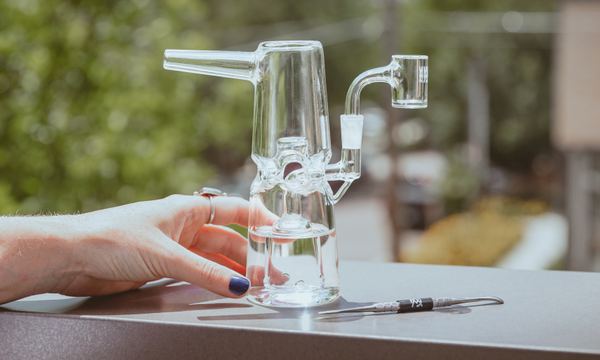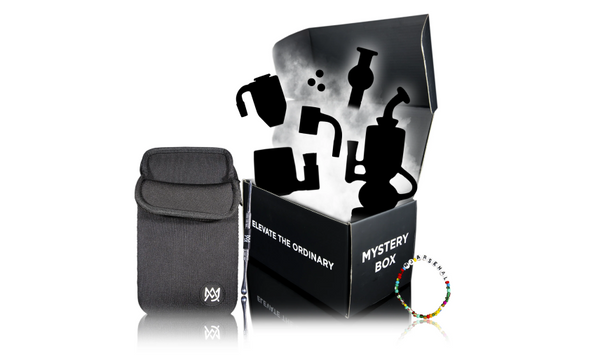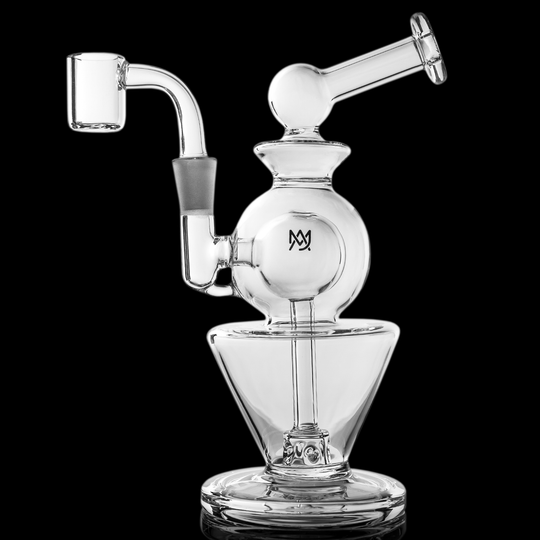
Compare Borosilicate Glass vs Quartz
Every time you shop for glass, you’ll likely come across terms you don't find in everyday conversation—borosilicates, mineral quartz, silicon dioxide, and many other words not out of place in an eighth-grade science class.
You just want a dab rig you can vape without worrying about durability or upkeep. But, like most things in life, the more educated you are about your purchase, the more likely you are to buy something you're happy with.
Glassmakers don't just throw these terms around for no reason. The material and makeup of your dab rig and banger directly influence the quality and flavor of your vapor. Knowing what you want and how to get it will improve your experience and help mitigate the hazards of working with high temperatures and sticky residues.
Quartz and borosilicate are two of the prominent glasses you'll find in dab rigs and accessories. Both are used in various industries for many different applications, but they differ significantly in physical properties, performance characteristics, and applications. The effects of time, temperature, pressure, and chemical exposure can be dramatically different for these materials.
It is important to be aware of the specific makeup of a glass item and how this affects performance. After all, if you're going to buy a dab rig that you hold up to your face, you need it to be made of a material that is strong, shock-resistant, safe, and reliable.
Let's go over some of the more important differences between quartz and borosilicate glass and discuss what they mean for your dab rig.
How are Glass and Quartz Different?
Natural quartz is a mineral composed of silicon dioxide, and its many varieties are semi-precious gemstones. As a result of its abundance and high thermal conductivity, quartz is widely used in many large-scale applications—glass aggregate, abrasives, foundry materials, ceramics, and cement.
Manufactured glass comprises about 75% silica; in contrast, quartz glass is up to 99% silica. It's also called fused silica glass or fused quartz. Crystalline quartz usually looks like clear or cloudy, naturally-occuring crystals that occur naturally. However, encountering this kind of cloudiness in manufactured glass signals impurities and defects.
When heated at suitable temperatures, quartz can be molded like an all-purpose glass. The final product becomes a hard substance with a solid appearance and clear crystal formation. The temperatures required to mold quartz are far higher than the temperatures used to mold glass.
This fundamental difference is why quartz can withstand much higher temperatures than manufactured glass.
Quartz crystals also have piezoelectric properties, which means they can develop electric potential upon the application of mechanical stress. This is why quartz crystals are built into the world's most accurate watches. Don't worry—this doesn't mean your quartz banger can zap you. The electrical pulses are so slight that you can't feel them.
While the electrical properties are a unique component of quartz, they don’t exactly enhance the dabbing experience. Instead, let’s take a look at the different traits of quartz and borosilicate glass that make each material useful for glass dabware.
Trait #1. Durability
Typically, we think of durability as "how tough something is." But in glassmaking, durability goes beyond whether or not a material breaks—we also have to consider the different situations that might cause something to break.
For example, you may be regularly handling and passing dabware. It also needs regular cleaning, which requires enough toughness against routine scrubbing and tapping. That’s why borosilicate glass is perfect for miniature dab rigs—it’s strong enough to withstand these different situations without being too expensive.
Trait #2. Hardness and Toughness
"Toughness" refers to an object's ability to resist breakage from sudden stress or force, while "hardness" refers to its resistance to scratching. Quartz is among the hardest materials on Earth (although diamond takes the top prize).
For example, you can't scratch quartz with steel, but you can break it. On the other hand, borosilicate glass is a softer material than quartz because steel will definitely scratch it. However, its toughness is comparable to quartz.
In its lifetime, a piece of glass is likely to be broken or chipped at least once. The glassmakers in our network are adamant about the importance of longevity in our materials. The goal is for your glass to maintain its shape and smooth surface for as long as possible.
Trait #3. Tensile Strength
Another important factor in durability is an object's tensile strength, which is the resistance of a material to breaking under tension. Borosilicate has a rating of 280 megapascals (Mpa), which is high compared to quartz with a mere 50 Mpa.
This data tells us that quartz is harder when compared to borosilicate glass, but quartz is also more brittle. In other words, it breaks rather than bends, so it can't take the stress from multiple directions at once like borosilicate glass. This makes quartz strong enough for rods and joins, but not as functional for thin, narrow supports.
As a result, it's complicated to manufacture small, thin, or narrow quartz pieces, so it's much cheaper to use borosilicate glass as structural glass for pipes and dab rigs.
Trait #4. Heat Tolerance
Heat tolerance refers to an object's ability to withstand temperature changes. Quartz can tolerate extreme temperatures over 1,100° C (2,000° F). On the other hand, borosilicate glass can withstand elevated temperatures up to 700° C (1,300° F).
When the glass begins to soften due to the hot temperature, the material becomes less resistant to pressure. Borosilicate glass is less forgiving than quartz, so it is more likely to crack in ultra-hot conditions. This means that, of the two materials, quartz is more suitable as your dab rig's heating element (the banger) than borosilicate glass.
Trait #5. Thermal Shock-Resistance
Quartz is highly stable and thermal shock-resistant—this means it doesn't crack when exposed to rapid changes in temperature.
One of the most important factors for determining durability is whether or not your glass can handle a sudden temperature change. By definition, a thermal shock is a rapid temperature change.
For example, running heated glass under cold water can cause thermal shock. Exposure to high temperatures can lead to thermal expansion. Then, if the glass cools too quickly, it becomes stressed. When a hard material like glass or ceramic experiences a higher temperature shock than it can tolerate, it can shatter and explode violently.
Never attempt to cool off a hot glass piece by running it under a cool liquid. Always allow your glass dab rig and quartz banger to cool slowly until it reaches room temperature.
Trait #6. Ductility
The word "ductility" refers to an object's ability to be drawn out into a thin wire. Glass is extremely ductile, whereas quartz is not.
When glass is heated, it becomes more malleable and easily deformed without breaking. Quartz, on the other hand, will break before it bends or stretches very much. It's much more brittle than glass, and it takes thicker layers of quartz to form it into a curve or a circle. This makes it more expensive to form into the large, thin orbs and narrow tubes found on most water pipe designs.
Which is Better for Dabbing?
For dabbing, borosilicate glass and quartz work well together. Quartz is a far better heating element because it is more resistant to the high temperature than glass, but borosilicate glass is best for the dab rig itself.
The process of making thin, small pieces composed of quartz isn't feasible—it's too expensive, and it's not necessary for the structure of the dab rig anyway. Borosilicate glass is strong enough to act as the structural component of your dab rig and is far easier to mold into small, thin shapes.
Quartz’s natural properties are why it excels for the construction of carb caps and bangers. Meanwhile, borosilicate glass is best used to construct the dab rig’s overall structure.
Is Manufactured Glass Suitable for Bangers?
In a word—no.
In a few more words: plenty of glassmakers will sell you a cheap manufactured glass banger, and it'll do the job for a short time.
However, the properties of manufactured glass increase the risk that it will break down much faster than a true quartz banger. This creates the potential for injury if the glass breaks during use. Incidentally, that's the time when it's most likely to break since you're applying intense heat to the glass.
That's why MJ Arsenal doesn't sell glass bangers. We're not interested in making a quick buck—we want to offer only high-quality, resistant, and durable products that will last for a long time, even with heavy use. Our bangers are made from 100% mineral quartz, so you never have to worry about breaking under normal conditions.
On the other hand, we proudly craft our dab rigs from borosilicate glass. This is what makes our rigs strong, lightweight, and affordable, all at the same time.
Conclusion
It's clear that quartz is far more durable than borosilicate glass, but it's also more difficult and expensive to mold. Borosilicate is strong enough for use in dab rigs without being too expensive, and it's also easy to work with.
With borosilicate glass, you can create both large and small pieces that are thin and versatile. This makes it ideal for use in your dab rig while still maintaining its heat tolerance and thermal shock resistance.
You don't have to choose between borosilicate glass and quartz when you buy an MJ Arsenal dab rig. We use high-quality, reliable components at every stage of the construction process to create products as strong as they are beautiful.
Check out our borosilicate glass dab rig collection today to find the perfect mini dab rig for your setup. Each one of our rigs comes with a pure quartz banger, and we just dropped a new line of quartz bangers in different styles so you can customize your dab rig.

 Alpine Series
Alpine Series
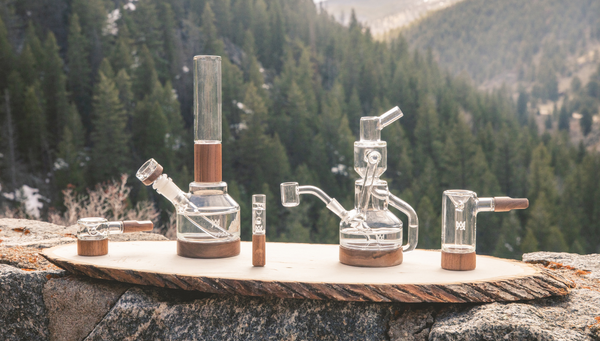
 Bubblers (NEW)
Bubblers (NEW)
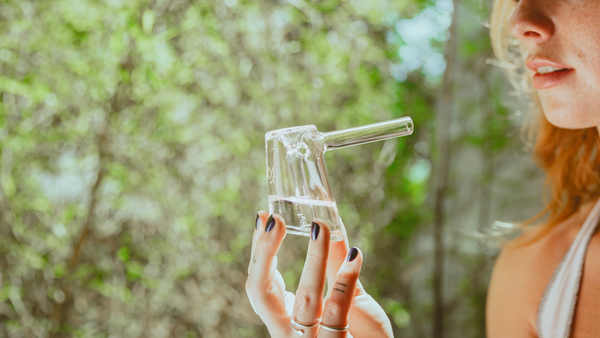
 Hand Pipes (NEW)
Hand Pipes (NEW)
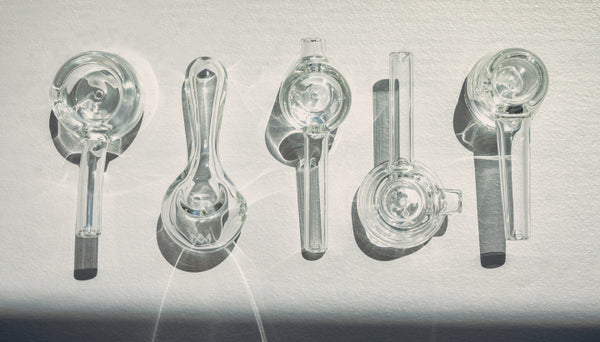
 Dab Rigs
Dab Rigs
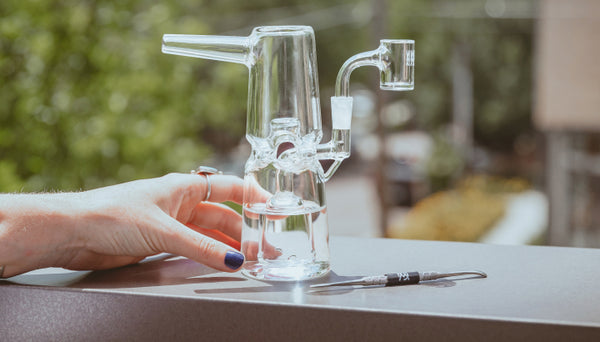
 Bongs (NEW)
Bongs (NEW)

 E-Rig Accessories (NEW)
E-Rig Accessories (NEW)

 Mystery Boxes
Mystery Boxes

 Accessories
Accessories
